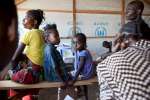Returns to Caprivi small-scale but significant, says UNHCR
News Stories, 19 April 2005

DUKWI CAMP, Botswana, April 19 (UNHCR) – A convoy of 12 may seem minuscule in a world used to seeing mass returns to Afghanistan and Liberia. But as the repatriation of a dozen refugees to Namibia's Caprivi region shows, size does not always determine the significance of the journey home.
A group of eight adults and four children left Botswana's Dukwi camp on Friday for the Caprivi region, a strip of Namibian territory wedged between Botswana, Zambia and Angola that has been caught in the region's conflicts for decades. Friday's return convoy was the first between the two countries since 2002.
"The numbers are low but the significance of this movement is high. These returnees broke the ice," said UNHCR's chief of mission in Botswana, Benny Otim, noting that more than 50 refugees registered for repatriation within days of hearing about the return date. "No doubt we have reached a turning point."
Last week's returnees were mainly young Namibians who decided to return home to their families in the western parts of the Caprivi region after more than five years in exile.
One of them, Moesi, returned with his two-year-old son, Beckham. His wife will follow after completing a degree in Humanities in Botswana. "I feel ok today. I will see my parents and they will see their grandson for the first time," said Moesi, who decided to return because he does not see a future in Botswana. His family is in Namibia, where he wants to study and get on with his life.
Fiona returned with her mother Constance and her four-year-old son David. "Life at home is going to be alright," she said, adding that she planned to continue her education. Her mother wants to take on gardening, growing watermelons and sugarcane to make a living for her family.
The convoy started before 5 a.m. on Friday and comprised the usual vehicles: a bus for the returnees, a truck for the luggage, a police car for road safety, a military truck for security, an ambulance and a number of cars for officials from UNHCR, the Botswana government and the Namibian High Commission in Gaborone.
Aside from a massive obstacle along the way – an elephant that chose to cross the road just as the cars were passing – everything else went smoothly on the six-hour drive peppered with sightings of ostriches and the occasional kudu antelope.
Border formalities on the Botswana side were short and simple, as all the refugees had their voluntary repatriation forms that served both as temporary ID and travel documents. As the children enjoyed a meal of sweet maize pap, the adults sneaked quick looks across the border at Namibian territory, less than 20 metres away.
UNHCR Representative in Namibia Hesdy Rathling joined the group at that point, taking over from the Botswana team. He explained the procedures: "After entry formalities, UNHCR will take the returnees to Katima Mulilo, the capital of the Caprivi region. There, each individual will receive 200 Namibian dollars (about US$32) before being transferred to their places of origin. For one year, UNHCR Namibia will monitor the reintegration of the returnees, as we do in all repatriation operations."
The refugees had been a little apprehensive about the way their native Namibia was going to receive them. But as they approached the Namibian border in the late morning, they were warmly welcomed home by Namibian government representatives, UNHCR officials, family and onlookers in an improvised but moving little ceremony at the Kasane border post.
A Namibian TV crew documented the official speeches and solemn faces during the short ceremony. "All obstacles to repatriation are now a thing of the past," said the governor of Caprivi. "Brothers and sisters, you have voluntarily decided to come back to your motherland. We are welcoming you and we hope that many more will follow your example."
These words wholly changed the impassive mood. Guests and onlookers started cheering and clapping. They spontaneously formed a queue to greet and hug each returnee. At that stage, even the cool-looking men in the group lost their composure and surreptitiously wiped their eyes, moved by the small but intimate welcome home.
By Melita H. Sunjic in Botswana and Namibia













































